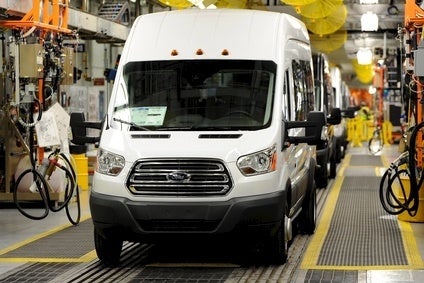
The Transit van has made its North American production line debut with more durable paint, thanks to what Ford claims is industry-first technology now in use at its Kansas City Assembly Plant.
Production of the new ‘One Ford’model line began on 30 April, ahead of US and Canadian sales starting this summer.
Ford said Transits built in Kansas City are the first to use a new ‘two wet monocoat’ paint process developed by the automaker and its suppliers. The technology results in more durable paint, uses less energy and water, and reduces carbon dioxide and particulate emissions compared with conventional paint processes.
The new paint had to meet or exceed Ford’s own tough standards and was subjected to a battery of tests that simulates typical conditions the vehicles will encounter over 10 years. The paint was tested for its resistance to chipping and scratching, pollutants and sun exposure. Advanced weathering testing indicates that paint applied with the new technology will retain 90% of its gloss at four years in service compared to 1% gloss retention for paint applied using a conventional monocoat process.
“Durability was a critical consideration when we initiated this project,” said Dennis Havlin, Ford’s global paint engineering development and launch supervisor. “The advancements in paint chemistry enable us to deliver the appearance, performance and durability our customers demand.”
In addition to making paint tougher, the process reduces painting time and energy use by cutting the number of coat applications from three to two and the number of drying procedures from two to one.

US Tariffs are shifting - will you react or anticipate?
Don’t let policy changes catch you off guard. Stay proactive with real-time data and expert analysis.
By GlobalDataThis innovation is part of a wider Ford plant to reduce plant carbon dioxide emissions and water use. The automaker wants a 30% reduction in carbon dioxide emissions per vehicle produced from 2010 to 2025 plus a 30% reduction in water use per vehicle produced from 2009 to 2015.
The new paint process uses less energy and water, and reduces carbon dioxide and particulate emissions compared with conventional paint processes. The reduction in paint and energy consumed is expected to result in 9,500 tonnes fewer carbon dioxide emissions and a 35 tonne saving in particulate emissions per year. An innovative dry scrubber system will help save more than 10.5m gallons of water. Overall, the system should save 48,000 megawatt hours of electrical power, enough electricity to power 3,400 homes.
The two wet monocoat process uses a primer coat that requires only a few minutes of open air drying time before the colour coat is applied. The colour coat is formulated with the same appearance and protection properties of the clear coat, which eliminates the need for a separate clear coat. The painted body is fully cured in an enamel oven after the colour coat is applied. The total process removes one paint application step and one oven drying step when compared to conventional paint processes.
The new paint procedure is being used for white vehicles which account for 80% of Transit production at Kansas City. As each colour must be developed uniquely for the two wet monocoat process, other colours will be considered based on demand. A conventional three wet process – primer, base coat, clear coat – remains in use for metallic finish vehicles.
Gaining production efficiencies
The two wet monocoat system helps increase production efficiency, Ford said. The more streamlined process takes the vehicle body through an electrostatically bonded corrosion-resistance (E-coat) bath. The van body remains on a carrier that is lowered into the E-coat by four pendulums, rather than being manually removed from the carrier and attached to chains to be taken down, requiring a repeat of the same steps before it moves on to the paint booth.
The pendulums take the vehicle body into and out of the bath at steep angles, reducing the length of the bath by as much as 320 feet. The paint operation requires less space than that used in production of the smaller Fiesta car.
“The two-wet monocoat process allows us to design a system considerably smaller than a conventional paint shop, especially with regard to a vehicle of this size and complexity,” said Havlin. “Because painting time is cut down, the technology enables greater productivity using less equipment.”
Environmental savings
A conventional paint process uses water filtration – known as a wet scrubber system – to remove the overspray from the air in the paint booth that produces sludge. The new dry scrubber system pumps the air through a filter containing limestone that can be recycled. The dry scrubber system alone reduces energy use and carbon dioxide emissions by 44%, cuts particulate emissions by 99% and uses 75% less water a year.



